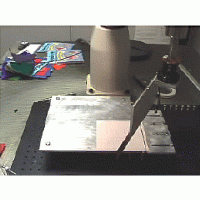
The design and manipulation of foldable objects like paper bags, newspapers, fast-food containers, tents, mirrors for space telescopes, cardboard boxes, and clothing present some challenges for robots; we hope that exploring origami folding will lead to some new insights into these hard problems.
Our primary interest in origami is manipulation. What skills do human origami experts use? http://folds.net lists some skills from simple to advanced. Pureland origami is the most basic, allowing only mountain and valley folds. We have modelled two basic types of folds, simple folds and book folds, that, with the exception of some 3D manipulation, completely model Pureland origami. We have developed a complete automatic planner for book-foldable origami; the animated folding of the samurai hat to the right is computer-generated.
We have also designed and built a prototype of a machine to fold simple origami. Below are movies of a robot in the manipulation lab folding two origami pieces: a simple paper airplane and a hat. The movies are in real time, but the repositioning of the paper has been edited out of the paper airplane folding. The folding is open loop (the position of the paper is not sensed), so the accuracy is much less than what a human could achieve.
We are currently working on understanding more complicated origami skills like reverse folding, squash folding, the rabbit ear, and prayer folding. These manipulations treat the paper as a compound spherical closed chain, and manipulate multiple creases simultaneously. One interesting result to think about — an ordinary shopping bag cannot be folded flat without bending the facets. (The flat and open configurations are isolated points.) This might be considered a ‘design feature’; the fact that the facets resist bending tends to keep the shopping bag open or closed. The fact that paper is not stretchy suggests that it may even be the case that bending the facets is not enough, and that some crinkling of the paper must occur.

